| |
| |

Camille Pissarro was born in Saint-Thomas,
Virgin Islands, on July 10, 1830 to a Jewish French father
(Abraham) of Portuguese origin, who had settled in this Danish colony
of the West Indies a few years earlier, and to a
creole mother named Rachel Manzano-Pomie native of Danish Antilles.
His father sent him to Paris,
France from 1842 to 1847 to receive his early education at a boarding
school in Passy, a small village near Paris. As early
as that time, he spends his free time sketching the countryside and
visiting Parisian museums.
On return to Saint-Thomas, he forms a
friendship with Danish painter Fritz Melbye, with
whom he flees in 1852 to Caracas , Venezuela where he will stay two
years, so as to avoid working in his father's business.
In 1855 his father ends up yielding to
his will to become a painter and sends him again to Paris,
where the French branch of his family was going to give him financial
support, in order to have him follow a more serious training.
|
|
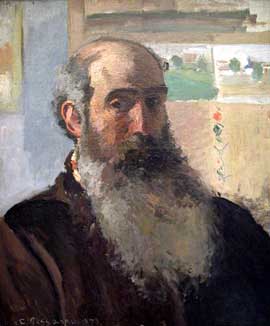
Self-portrait
1873

Musée d'Orsay, Paris
|
 THE ACADEMY SUISSE THE ACADEMY SUISSE
Pissarro will not follow a regular formation
there, but instead will work at the "Swiss Academy". This prestigious
Parisian workshop ( founded in 1815 and led since 1844 by Swiss painter
Charles Gleyre ) provided young artists with models.
The Swiss Academy did not offer courses, but made it possible for young
painters to study together nudes, the price of a model being too high
for a sole artist.
This academy was an important gathering
place for those artists whose ambitions and sensibilities lay
outside the teaching of the official schools, for it offered greater
opportunity to discuss and develop personal ideas about painting and
art in general. It is there that he will meet Monet
in 1859, Guillaumin and Cézanne in
1861.
|
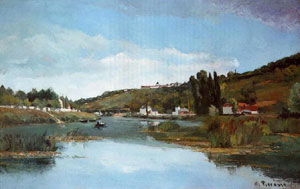
Banks of Marne River at
Chennevières
1864-65
National Gallery of Scotland
|
|
At that time, he paints in the
surroundings of Paris on the edges of the Seine, Oise and Marne rivers,
his work being inspired particularly by the style of Corot,
whose works he had admired during the World Fair of 1855,
and with whom he gets in contact. It is from there that his vocation
as a landscape painter was born.
In 1859, he sent his first work to the
official Salon and was admitted to expose there. In 1860, he lives with
Julie Vellay, the daughter of a Burgundian wine grower, of whom he will
have eight children .
|
In 1866, Pissarro and his family settled in Pontoise,
then in Louveciennes in 1869, always keeping an
apartment in Paris from where he could go to the Café Guerbois.
It is there that he met Manet in 1866.
 PONTOISE PONTOISE
| |
Except for 1867, he was regularly accepted to
the Salon, but these admissions did not bring him many sales,
so that he will have during many years financial problems to support
his large family .
At this time, his greater experience compared to that of
Monet, Renoir and Sisley, confers his paintings a greater maturity. He
uses color modulations to suggest space depth while
keeping a great rigour in composition. These
qualities which one also finds in the works of his pupil
Cézanne make of Pissarro a painter much more considered today
that he was in the past.
In Pontoise, he works with Guillaumin,
while frequently visiting Doctor Gachet in
Auvers-on-Oise.
|
|
|
Jallais Coast, Pontoise
1867
Metropolitan Museum of Art, NY
|
During the franco-prussian war of 1870, Pissarro, of Danish
nationality, after a short stay in Brittany, will seek refuge
in London at Monet's side . He will leave behind him in
Louveciennes all his paintings, as well as those which Monet had left
him in deposit. Those will be used by Prussians as boards to carve the
meat and for the majority of them will be destroyed. On the edges of
the Thames river, Pissarro will discover the work of John Constable,
Joseph M.W. Turner and Richard Bonington.
After the war, he settles again in Pontoise, where he will
remain the next ten years.
|
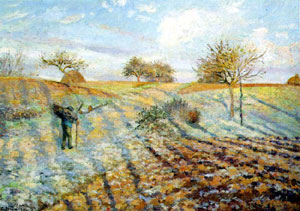
Hoar frost
1873
Musée d'Orsay, Paris
|
|
An important moment in painting history is the collaboration
between Pissarro and Cézanne from spring 1872 until the end of
May 1874.
They knew each other since more than a decade, and
Pissarro welcomes Cézanne who comes to work with him. This latter
settles with his family, initially in Pontoise, then in Auvers-sur-Oise
in 1873 in a housing provided by Dr. Gachet.
Their joint work will appear particularly fertile for
both of them. Cézanne will adopt the manner of
Impressionist painting while he strengthens Pissarro
in his desire to carry out compositions built with an autonomous
picturality .
|
1874 was the year of the first private
Impressionist exhibition. Pissarro, senior of the Impressionists, will take
part in the eight shows of the group.
This fact is important because it reveals
something about Pissarro's relation to Impressionism generally : he was
the patriarch and teacher of the movement, constantly
advising younger artists, introducing them to one another, and
encouraging them to join the revolutionary trend that he helped to
originate.
 LANDSCAPE WITH FIGURES LANDSCAPE WITH FIGURES
Art critics will recognize the talent of
Pissarro only at the end of the 1870s. He will answer waitings of the
public while devoting himself more to decoration. His financial means
will then enable him to buy a house in Eragny in 1884.
| |
Towards the end of 1882, Pissarro left Pontoise to
settle in Osny , a village close to Pontoise, where
he continued his work, sometimes in company of his friend Gauguin,
who then belongs to his circle of disciples, as well as
Guillaumin, and Cézanne who visits him from
time to time.
From this time, his work evolves from simple to more
diverse landscapes such as street scenes, market scenes with many
characters, interiors with peasants. The landscape painter becomes also
a painter of figures .
His pallet also moves towards more contrast in colors
and smaller strokes. The weaving of pictorial surface is composed of
particles of pigments of equal value.
In 1884, he settles in Eragny , close
to the Epte river, where he will remain until his death.
|
|
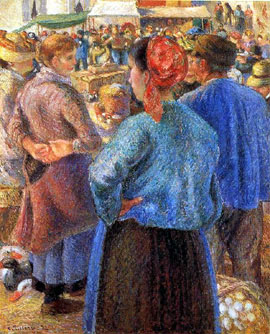
Poultry market , Pontoise
1882
Norton Simon Foundation
Los Angeles
|
 DIVISIONISM PERIOD DIVISIONISM PERIOD
About the middle of the 1880s, he met Seurat and was
impressed by what will be named later neo-impressionism,
and the divisionist technique, without totally adhering to Seurat
or Signac's systematic and scientific approach.
|
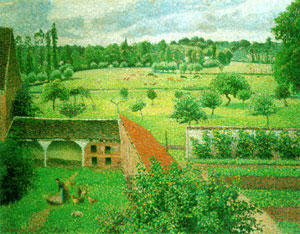
View from my window,
Eragny
c. 1886-88
The Visitors of the Ashmolean Museum
Oxford
|
|
For a moment he will adopt small pointillism's irregular
strokes, and will even exhibit with Seurat, Signac and his son Lucien
Pissarro in 1886.
Until 1890, he will execute divisionist
paintings on subjects such as cultivated landscapes, river
views or peaceful scenes of country work, although preferring small
strokes to the rigorous points of Seurat.
|
In 1890, on return of trips to Holland and
England which revived his love of nature and his admiration for his
Impressionist friends, Monet, Renoir, Degas and Sisley, he would turn
away from "the systematic division of our friend and regretted Seurat",
while keeping small tight strokes until the end of his work.
 CITY PAINTER CITY PAINTER
Pissarro's production, reduced until 1890,
will become more abundant when financial difficulties re-appear and
this although he suffers from an eyes' disease which prevents him from
working in open-air .
| |
In his late works, Pissarro will grant
to metropolitan views an interest hitherto only
expressed by Monet and Caillebotte.
He rents rooms in Paris, Rouen, Dieppe and Le Havre, from which he
paints dynamic perspectives of boulevards, places, rivers and bridges.
As for Monet, he paints alternatives and repetitions to fix
different lights.
One should see in this new evolution,
due partly to his eyes' disease and his desire to satisfy his now many
purchasers, Pissarro's social and progressist vision, in which what
seems ugly in industrial development as regard to established order,
may paradoxically appear beautiful.
In these city views, one can see again
his aptitude for space composition, with major perspectives traversed
by circulation and framed by buildings and alleys of trees, the whole
setting bathing in a harmonious city light.
|
|
|
Boulevard Montmartre, night
effect
1897
National Gallery, London
|
Art dealer Durand-Ruel, who contributed to Pissarro's
success in France and America, will devote him a monographic
exhibition in 1992 .
 PISSARRO'S
ESSENTIAL CONTRIBUTION TO IMPRESSIONISM PISSARRO'S
ESSENTIAL CONTRIBUTION TO IMPRESSIONISM
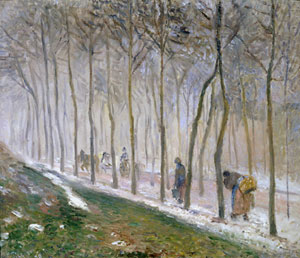 Road, snow effect
Road, snow effect
1879
New Walk Museum and Art
Gallery,
Leicester |
|
The contribution of Pissarro to
Impressionism is essential, by his work and his art which is one of the
most representative and most brilliant Impressionist expression, as
well as by the influence which he had on the other Impressionists.
Two of his pupils recognized until the
end of their life the importance which the teaching of Pissarro had had
for their art : Cezanne, whom he helped to paint more
clearly in the Impressionist way and to seek form by means of colors,
without any recourse to drawing, and Gauguin, of whom
he supervised early works.
Cézanne, who would sometimes introduce
himself as a pupil of Pissarro, will always keep a sincere affection
towards Pissarro whom he named "the humble and colossal
Pissaro" and of whom he will say "He was like a father for me.
He was a man to be consulted and someone like God "
|
|

